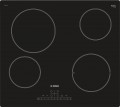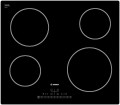Hob material
—
Enamel. The simplest and most common type of coating. Enamel combines low cost and good strength parameters. In addition, it can be produced in almost any colour. On the other hand, cleaning it can require considerable effort, and over time scratches and chips appear on such a surface.
—
Stainless steel. Steel surfaces have a nice appearance. In addition, they are stronger than enamelled ones; cracks and chips do not appear on them. Also, steel is quite easy to clean, but it is difficult to maintain its cleanliness — dirt appears easily, and even fingerprints can ruin a neat appearance. And for cleaning you need to use special tools, otherwise, you can scratch the stove.
—
Glass ceramics. Glass ceramics as a material is generally remarkable for its high thermal conductivity combined with good strength and heat resistance specs.
Schott Ceram and
EuroKera, manufacturers of this very glass ceramics, which manufacturers of household appliances install in their models, were especially successful in this. It made it possible to create original models of electric hobs, where the heating elements are located under a solid glass ceramic surface. The properties of this material allow it to be used with
induction hobs(see below). Such surfaces do not have protruding part
...s, and the location of the heaters is marked only by lines; thanks to this, you can conveniently move the dishes between the heaters, and cleaning such a surface is as simple as possible. However, there are also disadvantages: glass ceramics is less durable than enamel or steel. It requires dishes with a flat bottom, and spilling liquid on a flat surface is fraught with spreading over the entire stove and (not only). Also, this material is used in gas cooking surfaces "gas-on-glass". However, it is rather fashionable because, in addition to strength, it does not have key advantages over a tempered glass (see below) but costs significantly more.
— Tempered glass. The material used in gas-on-glass cooking hobs. it is used to make a surface over which gas burners are located. Such models have an original appearance, and the glass itself is scratch-resistant and can be cleaned well. Its strength and resistance to heat are much lower than that of glass ceramics (in fact, the latter has become the reason that tempered glass is not used in electric hobs), but these moments are more than offset by low cost.
— Cast iron. An original variant found in some premium gas models. The working surface, in this case, is made of the same cast iron as the burner grates, and the grates themselves are protrusions on the cast iron surface. It gives the entire structure an unusual, very strict appearance. And it increases its reliability: the design of the burner grates is such that they will not bend even under the heaviest dishes. On the other hand, cleaning such a surface can be quite laborious, and this option is not cheap. Because of this, there are only a few models with cast-iron surfaces on the market.Burners power
Nominal burners power. It refers to the power consumption of the heater. This parameter allows you to estimate how much electricity the burners will spend when operating at maximum heating intensity. At the same time, the heat transfer power of different burners can be different, and the actual heating efficiency will also greatly depend on the specs of the dishes. As a result, it hardly makes sense to evaluate the working capabilities of the hob by the power of the burners. It is quite possible to proceed from the fact that the burner will be enough for a pot of the same diameter.
Burner diameter
The heating power directly depends on the diameter of the burners. And, at the same time, the performance of the device and the speed of cooking. The larger the burner, the more heat dissipation it has. Also, the diameter of the burner allows you to determine what sizes of dishes are suitable for use on the hob. Indeed, for induction models, this value is critical for high-quality heating. Burners can have the following diameter:
- small — about 145 mm, power within 1200 W;
- medium — about 180 mm, power within 1700 W;
- large — about 220 mm and more, power within 2000 watts.
Some hobs use double ring burners that allow you to adjust the diameter of the heating zone. If the diameter of the burner is 180, 200, 220 mm, then it means that the heating zone on a particular burner can be narrowed or expanded, depending on the size of the dishes used.
Controls
The type of control used in the hob. The options might be:
—
Rotary knobs. Control based on classic rotary knobs. Sometimes buttons are also provided in the design but they are only responsible for the additional functions of the device. It is the knobs that control the switching on and power of the burners (and the combination of knobs and youch controls is indicated separately — see below). This type of control is known for its simplicity, convenience, reliability and low cost, which make it extremely popular — it is used in most modern hobs of an independent type (see above).
—
Touch controls. touch controls can control almost all functions of the hob, while the set of such functions can be very extensive. Among the advantages of touch sensors, one can note a stylish appearance, ease of cleaning due to the absence of protruding parts, and the touch controls do not need to be pressed — a light touch is enough. The main disadvantage of this type of control is its high cost, but it is mainly used in high-end hobs, where the price of touch controls is almost invisible compared to the cost of the entire device.
— Rotary knobs + touch controls. Combination of rotary knobs (see above) with touch controls. Note that only rotary knobs are enough for basic control of the burners, and buttons can also be used for additional functions — they are cheaper than touch controls. Therefore, t
...his type of control usually means that we have a rather expensive model with an abundance of additional functions. Among the advantages of touch controls, one can note a neat and stylish appearance, as well as ease of cleaning — they, unlike buttons, do not have slots and protruding parts where dirt can accumulate. And some models with similar controls have a rather unusual design — for example, only one rotary knob, the purpose of which is changed by commands from the touch controls.
— Touch + magnetic disk. Touch controls (see above), supplemented by a special rotary control — a magnetic disk. This disc is somewhat similar to rotary knobs, but it is called magnetic because of the fastening — with a permanent magnet, which allows you to remove the control. Most often, there is one disc for all burners; less often there are models with their disc for each burner. However, such a regulator has two key differences from rotary knobs. Firstly, the magnetic disk controls not only the power but most of the other functions of the hob. Secondly, the discs look neater and are more comfortable to use: they spin easily, and the detachable design makes them easy to clean and keeps children out of the way. However, it makes sense to use this control method mainly in high-end hobs with an abundance of functions.
— On the oven. As the name implies, such hobs do not have their control — it is carried out from the oven control panel to which the device is connected. This variant, by definition, only occurs in dependent models (see "Type").
— Slider. A kind of touch controls. Often they are elongated in a slender line; less often they are made in the shape of a circle. To adjust the heating intensity of the burners or quickly access other settings of the hob, slide your finger along the corresponding touch scale to the selected value. The convenience of slider control is that you can immediately set the required heating power by clicking on a certain area of the scale.
— Separate. Control using sensors or sliders (see the corresponding paragraphs), which implies the ability to fine-tune the operation of the burners individually - each of them has its own power adjustment scale. Separate control allows you to set the required heating level for a specific zone without having to first select a specific burner by tapping on the panel. It is more intuitive and gives you more flexibility when preparing different dishes overnight.Number of power levels
The number of temperature settings of the burner. The more power levels, the more accurately you can set the required temperature for cooking a particular dish. However, in most cases, nine levels are enough for home use. But, if you are a gourmet and often cook unusual dishes that require strict adherence to the recipe, then you simply need more temperature settings.
Input power
The input power of the hob is the maximum electric power consumed during its operation. This parameter is indicated only for models that are equipped with at least one electric hotplate. It is electric burners that are the highest consumption in terms of energy consumption. Additional functions such as auto-ignition require little energy, and a regular outlet is enough for them.
First of all, the requirements for the power mains depend on this parameter: it must be able to provide such power without overloads. It is worth noting that for household sockets the power limit is about 3 – 3.5 kW, with more power, you need to connect the hob to 230 V mains according to special rules. An alternative is to use a three-phase 400 V mains: most modern hobs with electric burners allow connection to both 230 V and 400 V mains.

